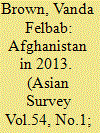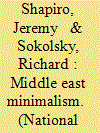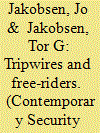| Srl | Item |
| 1 |
ID:
130198


|
|
|
|
|
| Publication |
2014.
|
| Summary/Abstract |
Uncertainties about the 2014 security, political, and economic transitions pervaded Afghanistan in 2013. The failure in 2013 to sign a U.S.-Afghan security agreement permitting the presence of U.S. troops after 2014 deepens those anxieties. As ISAF forces continued to withdraw from Afghanistan, Afghan security forces now have primary responsibility for Afghanistan's security but still face critical challenges and an undefeated Taliban. Peace negotiations have been stalled. Politics were dominated by the upcoming 2014 presidential election that can renew the legitimacy of the existing political system or throw the country into turmoil.
|
|
|
|
|
|
|
|
|
|
|
|
|
|
|
|
| 2 |
ID:
145603


|
|
|
|
|
| Summary/Abstract |
RECENT PRESIDENTS of both parties have agreed that the United States has vital interests in the Middle East. But the region has become extraordinarily turbulent. Civil wars rage in Syria, Yemen, Iraq and Libya, where central authority and state structures have broken apart. Various regional powers are intervening in these wars, many of which serve as proxy contests between Iran and Saudi Arabia. America is fighting a war against ISIS in Iraq, Syria and, increasingly, Libya. Russia has intervened in the Syrian Civil War.
|
|
|
|
|
|
|
|
|
|
|
|
|
|
|
|
| 3 |
ID:
166609


|
|
|
|
|
| Summary/Abstract |
This article investigates the relationship between U.S. overseas troops and the willingness of the citizens of host states to fight for their country. The study joins the long-running debate about burden-sharing and free-riding among U.S. allies. Unlike most previous empirical studies, we focus on non-material or intangible measures of the underlying concepts. Our dependent variable estimates the proportion of citizens expressing a willingness to fight for their country. Scores at the aggregate-national as well as the individual level are shaped by the presence of U.S. military forces, which act as a “tripwire” signaling credible security commitments. This increases opportunities of (non-material) free-riding. We present both bivariate and multivariate analyses covering the period 1981–2014 to test this supposition. Findings indicate that once U.S. troop levels reach a certain threshold (between 100 and 500 troops), citizens’ willingness to fight drops significantly. This likely reflects non-material free-riding.
|
|
|
|
|
|
|
|
|
|
|
|
|
|
|
|